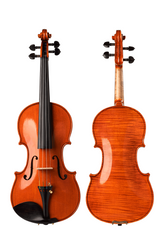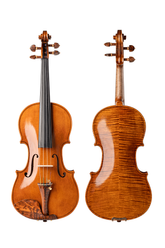The most complete knowledge of violin bow hair
Have you ever heard noises when playing the violin? Or is it difficult to pull out the desired sound? This may not be a problem with your playing skills, but the root of the problem may be a problem with the hair on your violin bow. So how much do you know about the bow hair?
What is the best violin bow hair?
With the development of the times, whether it is a violin or a bow, other materials can replace traditional materials, such as carbon fiber violins and carbon fiber violin bows. But after so many years of continuous experimentation, the most commonly used bow hair on the market is nylon filament, and the other is Horsetail hair. There are not many choices. And high-quality horsetail hair is undoubtedly the best material for making violin bows.
Why use premium horsetail hair for bowstrings?
When you are playing the violin, the bowstrings and the violin strings will vibrate when they come into contact with each other. After the vibration is processed by the violin, it is the sound of the violin that people hear. If the violin bow is made of nylon silk or a low-quality Horsetail and then used on the violin, the sound will be relatively small and there will be noise. And the violin bow made of high-quality horsetail hair has a lovely sound. Therefore, high-end violin bows are made of high-quality horsetail hair.
So why are bows made of nylon silk or low-quality Horsetail hair not so good? The main reason for this is the hairy scales. If you put high-quality horsetail hair under a microscope, you will find that its appearance is covered with fine and uniform scales, which are hairy. The hairy scales are the key structure that affects the performance of the bow. But nylon filaments have no hairy scales, and the hairy scales of poor-quality horsetail hair are uneven and defective.
The horsetail hair used to make bow hair refers to the hair in the middle of the Horsetail handle, not elsewhere. High-quality Horsetail hair is pure natural long-haired fiber, which makes it strong and wear-resistant, strong in tension, and strong in elasticity. The horsetail hair has a hollow core and a scale-like structure. This structure makes it ventilated and dehumidifying. The hairy scales will also produce better adsorption force in the friction with the strings. The bow made of high-quality horsetail hair has strong pulling force, good wear resistance, little influence by air humidity, and is not easy to break.
Violin bow hair mainly comes from horsetail hair in colder regions such as Siberia, Mongolia, and Canada. Colder climates cause horses to grow thicker and stronger coats.
Horsetail hair can be divided into ordinary horsetail, high-quality horsetail, and male horsetail in terms of grades. This is mainly distinguished from the diameter of the horse’s tail hair. Generally speaking, an ordinary Horsetail refers to the horse’s tail hair with a diameter between 14 and 20 wires, while the male horsetail refers to only the horsetail with a diameter of 17 wires or more.
If it is distinguished from the color, it can be divided into a white Horsetail and natural color Horsetail, both of which are high-quality Horsetail. After the white horsetail is manually selected and simply fumigated, there is no damage to the structure of the horsetail, and the appearance is pure and white. Natural color Horsetail refers to Horsetail hair that has not been treated with chemicals, and the color and structure of the Horsetail hair have not been damaged, but this kind of Horsetail is not as good-looking as the white Horsetail in terms of color, it will be yellowish, and it is not as good as the white Horsetail in appearance.
Therefore, if you are choosing a violin bow, you will often see descriptions such as white horse tail, male horsetail, or Mongolian horse hair, all of which are better materials.
The difference between high-quality horsetail hair and poor-quality horsetail hair
High-quality horsetail hair is simply processed without any damage to the structure of the horsetail hair, the hairy scales are complete and sharp, and its elasticity and toughness are not damaged. Inferior-quality horsetails are dyed white with chemicals and sold as high-quality white horsetails. The structure of the horsetail hair itself is destroyed. If you look under a microscope, you can see that the hairy scales have been greatly damaged. It will not be smooth during use, and it is more prone to noise.
How to distinguish real and fake horse tail hair?
The hair material of the bow is usually made of horse hair or nylon silk, so there are two common identification methods.
The first method: is the combustion method. Take out a bow hair and set it on fire. The smell of horse hair after burning is the same as that of human hair after burning, and rub the black heels left by burning with your hands, and it will immediately turn into powder. The bow hair made of nylon yarn smells like plastic after burning, and it will turn into a hard black ball after burning.
The second method: is the dyeing method. Take a bow hair, dip it with black hair dye, and wash it after 30 minutes, if it is still black after washing, then it is real horse hair, otherwise, it is fake horse hair.
Maintenance and replacement of violin bow hair
Horsetail hair is a consumable item and needs to be replaced frequently if it is not protected. If the protection is better, professional violinists need to replace it in about 3-5 months, while non-professionals can replace it once a year. This is because even if the bow is not used for a long time, the horsetail hair will turn yellow and become brittle due to time, which will also affect the playing effect. If it needs to be maintained in daily use, it is relatively simple.
1: Do not touch the bow hair with your hands. The sweat secreted from human hands can corrode the hair of the horse's tail.
2: After using the bow, wipe off the rosin on the bow with a cleaning cloth.
3: After using the bow, loosen the screw button to let the horsetail hair relax naturally.
4: When replacing the bow hair, if you are not a professional, please mainly ask a professional for help, so as not to damage the bow during the replacement.
Follow Fiddlover to learn more about the violin.





